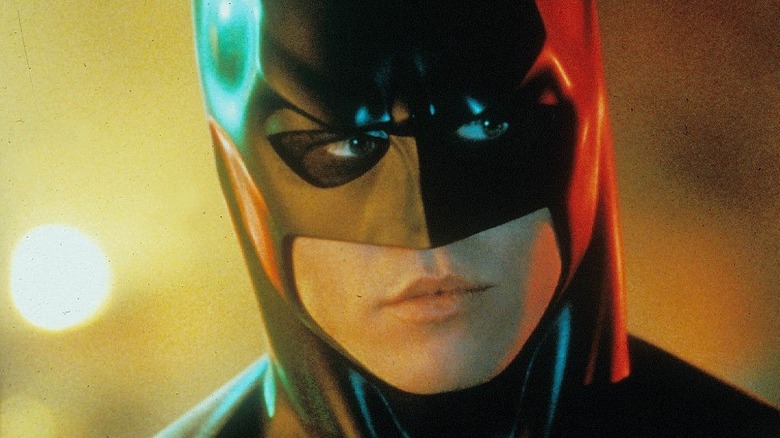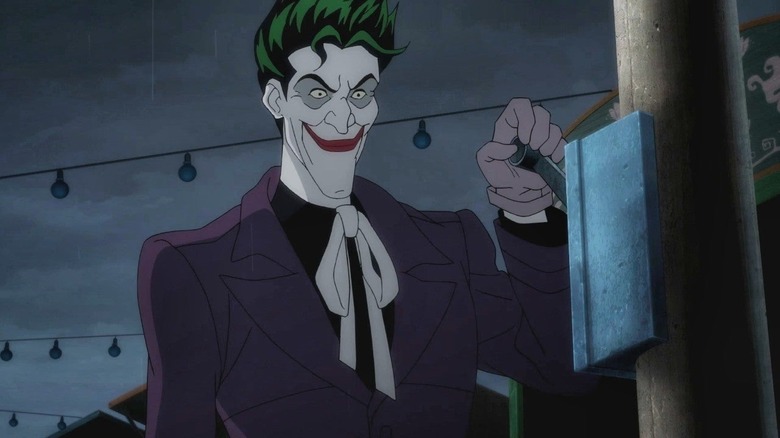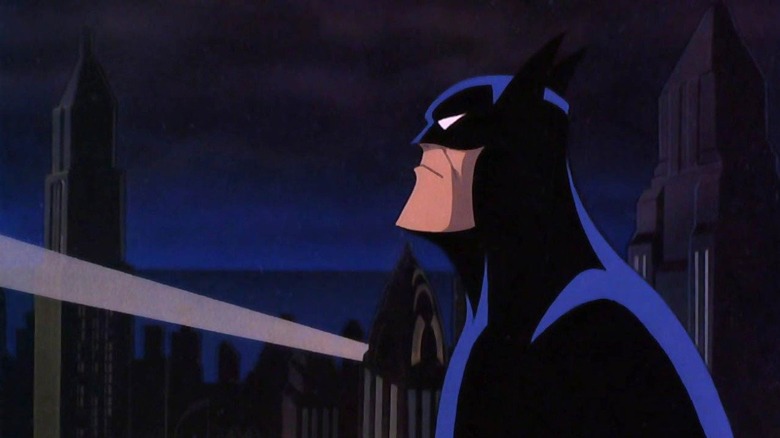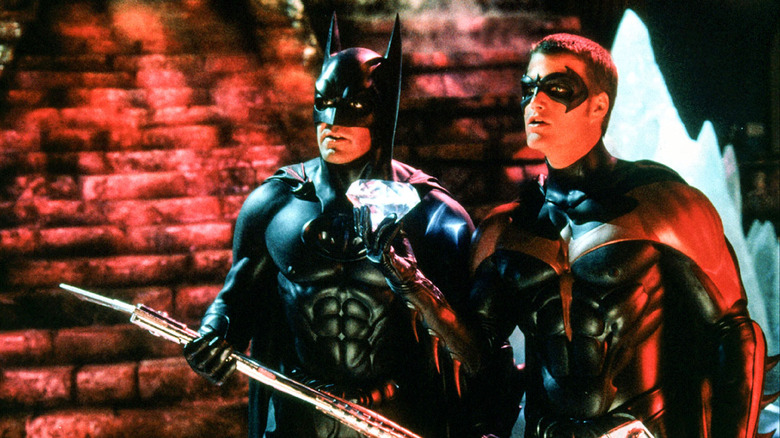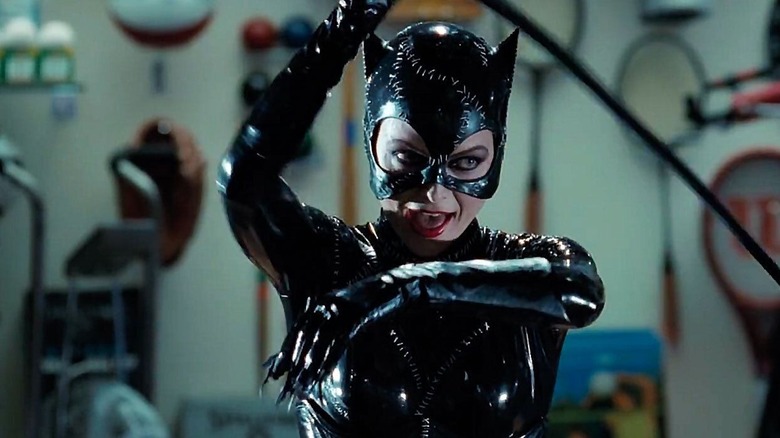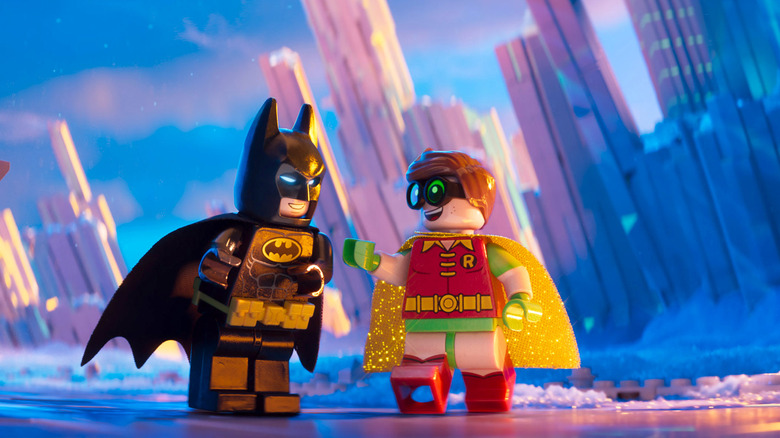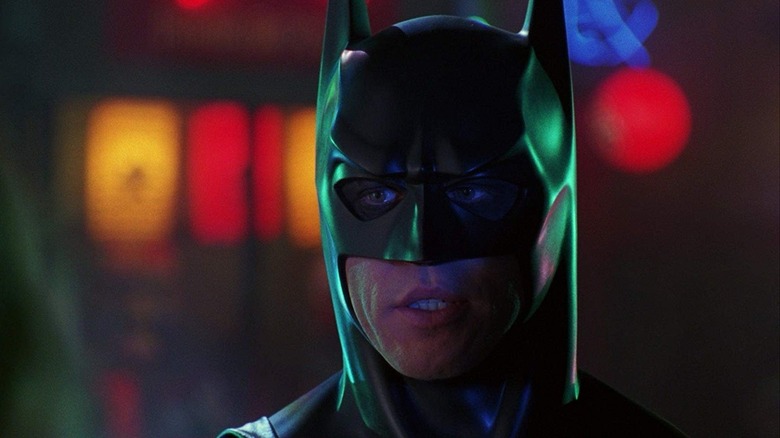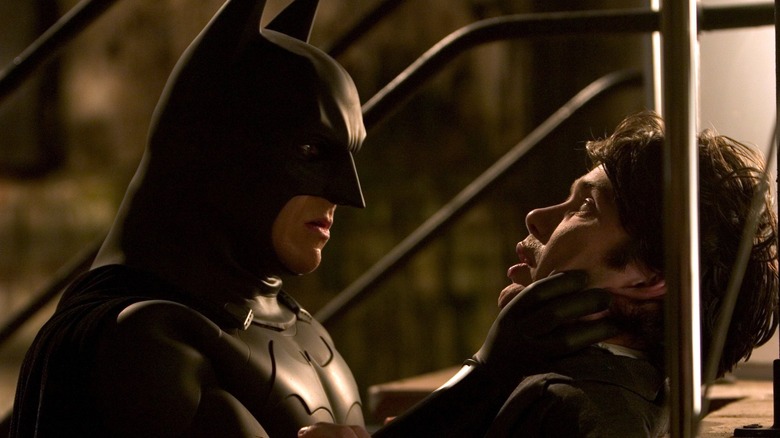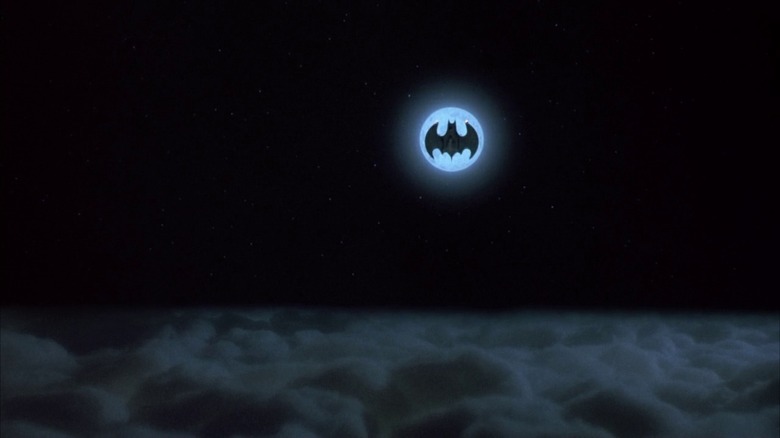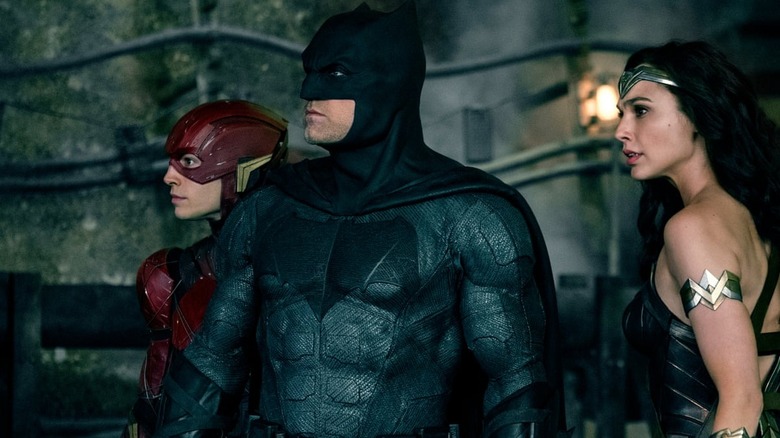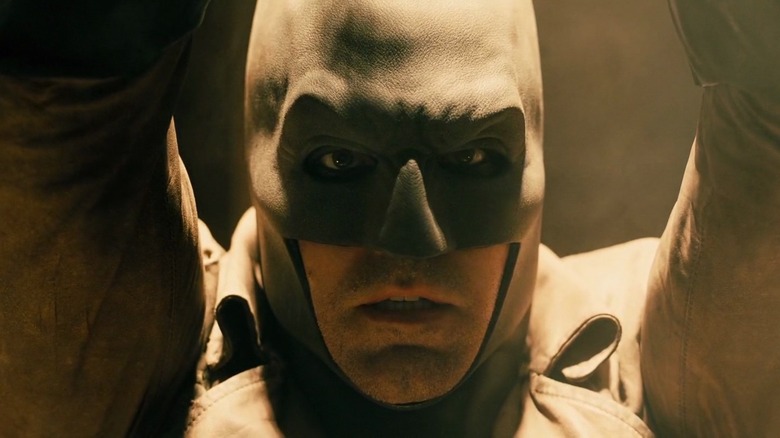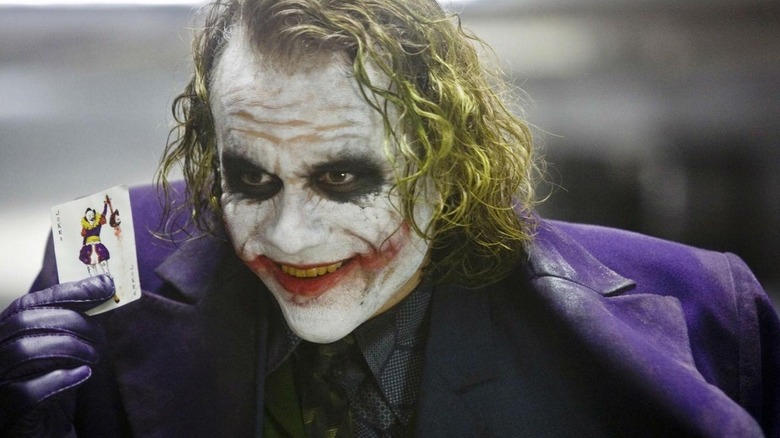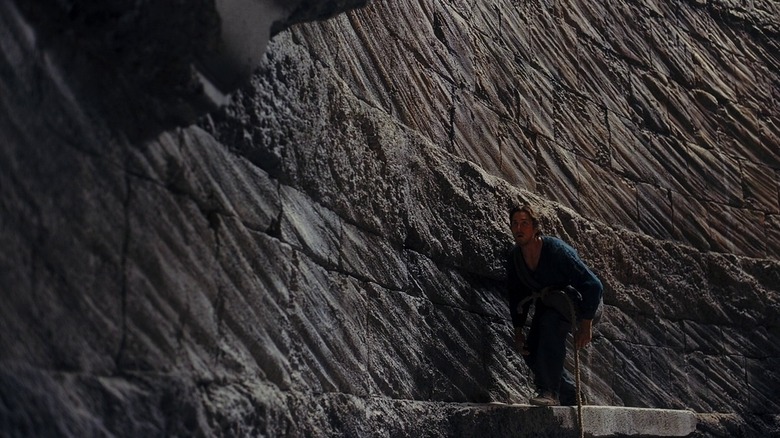Batman Movies Ranked By How Much Money They Made
Batman has been a seminal figure in comics for nearly a century. Though the character hasn't existed on the big screen for quite as long, he's still proven to be an enduring individual when it comes to theatrical movie exploits. It's a testament to how eternally interesting this crime-fighter is that he can endure several recastings and even translations into other mediums of artistic expression without missing a beat in his box office prowess. Combined, the features starring Batman have managed to crack $6 billion worldwide, a stunning figure that makes the character one of the most lucrative franchises in the history of cinema.
Still, by ranking each of the "Batman" movies by how much money they made at the worldwide box office, it becomes apparent that Batman — like other long-running movie franchises such as "Star Wars" and "James Bond" — is just as capable of producing a box office non-starter as any other movie. Let's take a look at every "Batman" title from lowest- to highest-grossing to appreciate the box office lows and highs of one of the most popular superheroes to ever grace the silver screen.
Batman: The Killing Joke
Sometimes, the lowest-grossing movie in a franchise is representative of a problem in a big saga. It can be indicative of franchise fatigue, a studio botching a marketing campaign, or any number of worrisome developments. In the case of "Batman: The Killing Joke," it's status as the lowest-grossing theatrical movie starring Batman is due to how the production was distributed. This project was supposed to follow the path of so many other animated "Batman" features aimed at grown-ups and go directly to video. However, in July 2016, it was announced that "The Killing Joke" would receive limited theatrical screenings distributed by Fathom Events.
Unable to play with constant screenings around the clock like a traditional theatrical release, "The Killing Joke" faced several challenges with its box office run. However, despite these obstacles, it proved to be a reasonably lucrative enterprise on the big screen. Its initial financial haul over two days of screenings was a record-shattering performance for Fathom Events. These numbers were strong enough to inspire further screenings to get scheduled, which allowed "The Killing Joke" to crack $4.3 million at the box office on a $3.5-million budget — a solid sum given that the film was meant to make its money back on home video revenue. While its theatrical haul may be well below all other "Batman" movies, the unique release situation for "The Killing Joke" means that it's far from a total flop.
Batman: Mask of the Phantasm
Right after the first two live-action "Batman" movies helmed by Tim Burton, a third feature-length adventure starring this caped crusader hit movie theaters in 1993. However, the preceding "Batman" films were accompanied by massive marketing campaigns and lots of hype in their summertime premieres. For "Batman: Mask of the Phantasm," things were a little different. This fully animated title, spun-off from the hit show "Batman: The Animated Series," arrived with a lot less fanfare and publicity. Voice actor Mark Hamill explained to The Hollywood Reporter that the feature was shifted from a direct-to-video production to a theatrical release late in the game.
Though this boosted the project's profile, it did have the severe adverse side effect of causing the marketing for "Mask of the Phantasm" to be nonexistent. The rampant advertising one would see for a normal Warner Bros. animated feature hitting the big screen was nowhere to be found. As a result, "Mask of the Phantasm" became a box office non-starter, grossing $5.6 million in its box office run, with no international numbers reported. Though a wipe-out financially, "Mask of the Phantasm" was not done yet. The film would eventually find a cult following on home video and garnered a large enough fanbase to warrant a theatrical re-release 25 years after its premiere. Some "Batman" movies are viewed as a success after one gargantuan opening weekend, but others, like "Mask of the Phantasm," take time to be seen as the successes they are.
Batman & Robin
After a trio of consistently successful live-action "Batman" movies, it was only a matter of time before one of these features stumbled financially. That development finally happened with "Batman & Robin," which seemed to be poised for massive box office glory on paper. After all, the movie featured 1990s cinema icons Uma Thurman and Arnold Schwarzenegger in significant roles. Combining performers like these with a new "Batman" movie seemed like a surefire recipe for box office success.
However, "Batman & Robin" became a noticeable box office dud that was plagued by disastrous word of mouth. The audience response turned out to be so negative that the film suffered significant weekend-to-weekend drops in North America. Such plunges were so severe that Ed Mintz of CinemaScore even declared the film's second-weekend plummet as a sign that the "Batman" franchise was finished on the big screen (via Entertainment Weekly). It didn't help that this new "Batman" movie opened up against major titles like "Face/Off" and "Men in Black." While "Batman" in 1989 managed to stand out even when competing against projects like "Ghostbusters II," a more divisive film like "Batman & Robin" was crushed by its enormous blockbuster competition. By the time its worldwide box office run was finished, "Batman & Robin" grossed $238.3 million globally — nowhere near enough to mitigate the project's $125 million budget and a noticeable step down from the last three live-action "Batman" movies. No box office winnings streak goes on forever, even ones involving Batman.
Batman Returns
The 1989 movie "Batman" had turned into such a lucrative pop culture phenomenon that it was going to be impossible for any sequel to be equally formidable at the box office. After all, how could any subsequent installment hope to match the pre-release excitement of seeing Batman realized as a big-budget blockbuster for the first time? "Batman Returns" was still game to give it a go, though, with a sizable marketing campaign and the presence of legendary Batman baddies Catwoman and Penguin.
Dropped into theaters in June 1992, "Batman Returns" wound up grossing $266.8 million worldwide and proved especially impressive in its North American run. Here, the film took in $162.8 million, which was enough to render it the third-biggest feature of 1992 in the territory and the biggest movie of the year among non-PG-rated fare. However, it did manage to come in 35% behind the global haul of "Batman," and much of that drop was due to its international total barely cracking $100 million. There was also the negative word of mouth emanating from the movie's perceived darkness. Outlets like the Sun-Sentinel claimed this hurt the film's long-term box office prospects domestically, where the film had a bigger opening weekend than "Batman" but noticeably steeper weekend-to-weekend drops. But even if it was a step down from the loot of "Batman," the sizable global haul of "Batman Returns" was still strong enough to be the cat's meow.
The LEGO Batman Movie
In February 2017, for the first time in nearly 25 years, an animated version of Batman was preparing to headline a theatrically released feature. Rather than being a spin-off of a TV cartoon starring Batman, though, this would be a spin-off of the megahit 2014 title "The LEGO Movie," with Will Arnett's LEGO Batman getting upgraded from scene-stealing supporting player to leading man. He would be accompanied by wacky LEGO versions of familiar Batman supporting players, including Alfred Pennyworth, Barbara Gordon/Batgirl, and, of course, Dick Grayson/Robin, making his first on-screen appearance in a theatrical release in 20 years.
Before its premiere, "The LEGO Batman Movie" was projected to have a North American opening on par with "The LEGO Movie" from three years prior. That didn't quite happen, with the film's eventual $53 million haul coming in 32% behind the domestic opening of "The LEGO Movie" (via Box Office Mojo). However, that was still a strong enough debut to set it on track for a $310.5 million worldwide gross, just under four times its $80 million budget. The residual goodwill from "The LEGO Movie" certainly played a part in this spin-off being successful, but so did the appeal of seeing familiar Batman mythos fixtures reconstituted in wacky comedic forms. While "Mask of the Phantasm" struggled to make a feature-length animated "Batman" movie a box office hit, "The LEGO Batman Movie" accomplished this task with ease.
Batman Forever
"Batman Forever" may be the most 1990s blockbuster that's ever been dreamed up in a lab. Val Kilmer, hot off "Tombstone," was recruited to replace Michael Keaton as Batman. As for the villains, Tommy Lee Jones ("The Fugitive") was picked to play Two-Face, while Jim Carrey — fresh off a trio of massive comedies in 1994 — was hired to portray The Riddler. Throw up-and-coming star Chris O'Donnell in the role of Dick Grayson/Robin, and you've got a movie cast primed to grab the eyeballs of 1990s moviegoers. It's a smorgasbord of all the biggest names in American cinema from that decade.
It wasn't just a new cast that made "Batman Forever" a departure from its predecessor. This production was also a much lighter fare compared to Tim Burton's take on Batman, with an emphasis on bright colors and campy humor. Though it got more mixed reviews than the last few "Batman" titles, "Batman Forever" drummed up a noticeably larger worldwide box office gross than "Batman Returns." Grossing $336.5 million globally, "Batman Forever" couldn't hope to match the lifetime gross of "Batman," but it made noticeably more than "Batman Returns" from just three years prior. It also ensured that "Batman Forever" was the fifth-biggest motion picture of 1995 at the worldwide box office. Doing everything possible to appeal to 1990s moviegoers worked like a charm in guaranteeing a sizeable box office success.
Batman Begins
Today, Christopher Nolan's take on Batman is one of the most famous superhero movie stories on the planet and helped spark a wave of reboots aiming to emulate its gritty tone and success. However, in 2005, before "Batman Begins" hit theaters, there was rampant speculation over whether or not the film could work. "Batman & Robin" was perceived as such a toxic movie that there were genuine concerns over whether or not this franchise would be attractive to audiences ever again. Thankfully, "Batman Begins" unleashed a marketing campaign emphasizing a unique darker tone that immediately separated itself from its predecessors.
Dropping in June 2005, "Batman Begins" made $358.9 million globally, narrowly edging out "Batman Forever" to become the second biggest "Batman" movie ever at the worldwide box office at the time of its release. Its box office performance was especially impressive domestically, where this Nolan directorial effort managed to become only the second "Batman" title ever to crack $200 million in this territory. The only quibble to be had here was the film's $153.5 million international total, which was below the overseas box office hauls of other 2005 blockbusters and even non-tentpoles from the same year like "Hitch." Still, improving almost 50% over the worldwide box office gross of "Batman & Robin" and scoring critical acclaim meant that "Batman Begins" accomplished its lofty goal of reviving the "Batman" franchise as a must-see event once again.
Batman
In an age where superhero movies arrive on movie theater screens monthly, it can be hard to imagine a time when the arrival of a "Batman" movie was something tantamount to an Earth-shattering event. But that's just what happened in 1989 with "Batman," Tim Burton's first foray into directing this DC Comics staple. Unlike prior non-"Superman" superhero movies, such as "Howard the Duck," "Batman" was a movie told with a significant budget and massive A-list actors like Jack Nicholson. Rather than being relegated to a lower-form of populace entertainment, it was an indicator that superhero movies could exist on a higher-profile level of cinematic storytelling.
The tantalizing unique aspects of "Batman" helped turn it into a must-see theatrical event. This led to "Batman" outgrossing fellow summer 1989 movies that were already part of established franchises, like "Ghostbusters II" and "Indiana Jones and the Last Crusade." This was achieved thanks to a gargantuan $411.3 million worldwide haul — one of the biggest global grosses for any movie at the time of its release. In this drastically different era for superhero movies, it was understandable to wonder if "Batman" could work on the big screen. This massive box office gross put any of those concerns to rest.
Justice League
"Justice League" may not have Batman in the title, but it certainly banked on the presence of this DC Comics superhero to help it succeed. With Ben Affleck reprising the part of Batman in the movie's top-billed role, "Justice League" also featured key supporting players like Commissioner Gordon and Alfred Pennyworth. The marketing for this title also put Batman front and center on posters and trailers, and the film's story began with the vigilante traveling the world to recruit a team of superpowered beings to help save the world.
Batman has often been at the center of massive box office hits, but he's not a guaranteed moneymaker. Interestingly, though, "Justice League" actually did make a sizeable chunk of change with $655.9 million worldwide, above all but three other Batman movies at the global box office. The problem here is the budget, which soared to a staggering $300 million. One of the most expensive movies ever created, it would've taken a miracle for "Justice League" to be profitable, especially after the divisive reputation of its direct predecessor, "Batman v Superman: Dawn of Justice." Such a miracle never happened here, as competition from fellow holiday season 2017 juggernauts "Thor: Ragnarok" and "Star Wars: The Last Jedi," among other issues, subdued the box office potential of "Justice League." Not even having Batman on the film's poster could make this film profitable.
Batman v Superman: Dawn of Justice
With the 2016 motion picture "Batman v Superman: Dawn of Justice," Batman was going somewhere he'd never gone before in live-action movies: a crossover with other DC Comics superheroes. Save for a name-drop of Metropolis in "Batman Forever" and an offhand comical reference to Superman in "Batman & Robin," the "Batman" films had been firmly planted in their own universes. As its title made apparent, "Batman v Superman: Dawn of Justice" brought that to a close by having Batman and Superman duke it out, with Wonder Woman — making her live-action movie debut — thrown into the mix for good measure.
Unsurprisingly, the prospect of seeing two comic book icons duke it out proved to be catnip for general audiences. "Dawn of Justice" grossed $166 million on opening weekend in North America alone, the biggest March debut ever in the region at the time and already over the lifetime domestic gross of "Batman Returns" (via CNN). However, word-of-mouth on "Dawn of Justice" proved extremely divisive, and the blockbuster had severely steep weekend-to-weekend declines from its opening. In the end, "Dawn of Justice" ended up grossing $872.4 million worldwide, ahead of all but two "Batman" films in history. However, that was below the global grosses of the first two "Avengers" movies and wasn't ideal for a film that cost a gargantuan $263 million to make. Still, this blockbuster did manage to produce a solid box office sum — the inevitable outcome when you smash two iconic superheroes together.
The Dark Knight
After "Batman Begins" proved to be a smash hit, a sequel was inevitably going to both exist and be successful. The promise of seeing Batman's most famous villain, The Joker, within the unique creative vision of Christopher Nolan was extra enticing. However, everything surrounding the project changed forever in the wake of Heath Ledger's tragic demise in January 2008. The performer tasked with playing The Joker, Ledger's shadow lingered over the movie and lent his performance an extra layer of urgent relevancy.
With all these elements combined, "The Dark Knight" was always poised for box office success. But nobody could've predicted just how massive it would be, with its opening weekend alone setting multiple box office records in North America (via Entertainment Weekly). From there, the project amassed a domestic haul of $533 million, a massive sum that was more than twice as big as 1989's "Batman," which was the last biggest "Batman" feature in North America. Thanks to a strong international showing that proved bigger than the worldwide gross of multiple previous "Batman" installments, "The Dark Knight" ended up cracking $1 billion. At the time, this made it only the fourth movie in history to exceed the $1 billion mark globally, which is a testament to how much this production resonated with audiences across the globe. The first entry in the "Batman" franchise to exceed that box office milestone, "The Dark Knight" changed the box office landscape for this series forever.
The Dark Knight Rises
The only problem that the massive box office haul of "The Dark Knight" presented was how much of a tough act it was to follow. Subsequent "Batman" films would have to reckon with existing in the shadow of a box office record-shattering behemoth. "The Dark Knight" had proven to be so abnormally big compared to past "Batman" movies that it was understandable to express curiosity over whether or not a potential follow-up could live up to expectations. Still, Christopher Nolan opted to barge right in and give it a go with "The Dark Knight Rises," which introduced Bane and Catwoman (portrayed by Tom Hardy and Anne Hathaway, respectively) as new adversaries.
"The Dark Knight Rises" didn't do too shabby for a sequel to such a massive movie, with its $448 million domestic gross only coming in 16% behind the North American haul of "The Dark Knight." It also made "The Dark Knight Rises" the second-biggest movie ever for Warner Bros. in that territory. More impressively, though, was how "Rises" did manage to improve on its predecessor in international markets, as it soared past $600 million in offshore numbers. This allowed the feature to cross $1.1 billion worldwide — a haul that ended up ahead of the global total of "The Dark Knight." Even with "The Dark Knight" providing a tough act to follow, "The Dark Knight Rises" wasn't afraid to rise to the challenge.
